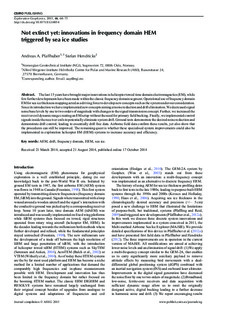| dc.contributor.author | Pfaffhuber, Andreas Aspmo | |
| dc.contributor.author | Hendricks, Stefan | |
| dc.date.accessioned | 2016-01-15T09:15:13Z | |
| dc.date.accessioned | 2016-01-25T10:06:17Z | |
| dc.date.available | 2016-01-15T09:15:13Z | |
| dc.date.available | 2016-01-25T10:06:17Z | |
| dc.date.issued | 2015 | |
| dc.identifier.citation | Exploration Geophysics 2015, 46(1):64-73 | |
| dc.identifier.issn | 1834-7533 | |
| dc.identifier.uri | http://hdl.handle.net/11250/2374668 | |
| dc.description | - | |
| dc.description.abstract | The last 15 years have brought major innovations in helicopter towed time domain electromagnetics (EM), while few further developments have been made within the classic frequency domain segment. Operational use of frequency domain EM for sea ice thickness mapping acted as a driving force to develop new concepts such as the system under our consideration. Since its introduction we have implemented new concepts aiming at noise reduction and drift elimination. We decreased signal noise base levels by one to two orders of magnitude with changes to the signal transmission concept. Further, we increased the receiver coil dynamic range creating an EM setup without the need for primary field bucking. Finally, we implemented control signals inside the receiver coils to potentially eliminate system drift. Ground tests demonstrate the desired noise reduction and demonstrate drift control, leading to essentially drift free data. Airborne field data confirm these results, yet also show that the procedures can still be improved. The remaining quest is whether these specialised system improvements could also be implemented in exploration helicopter EM (HEM) systems to increase accuracy and efficiency. | |
| dc.language.iso | eng | |
| dc.title | Not extinct yet: innovations in frequency domain HEM triggered by sea ice studies | |
| dc.type | Journal article | |
| dc.date.updated | 2016-01-15T09:15:13Z | |
| dc.identifier.doi | 10.1071/EG14034 | |
| dc.identifier.cristin | 1164793 | |
